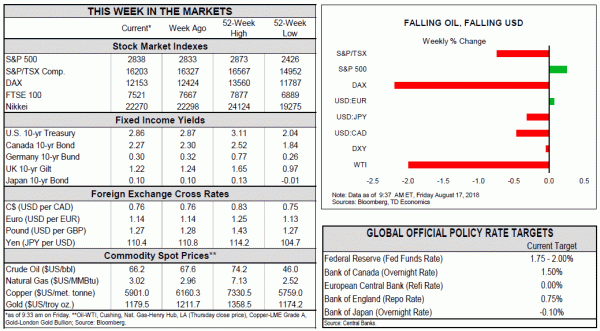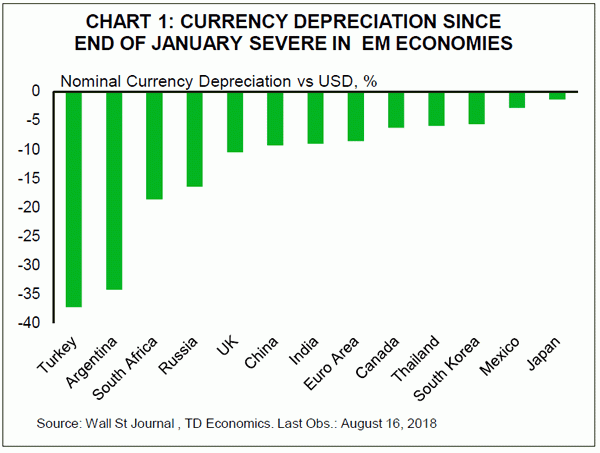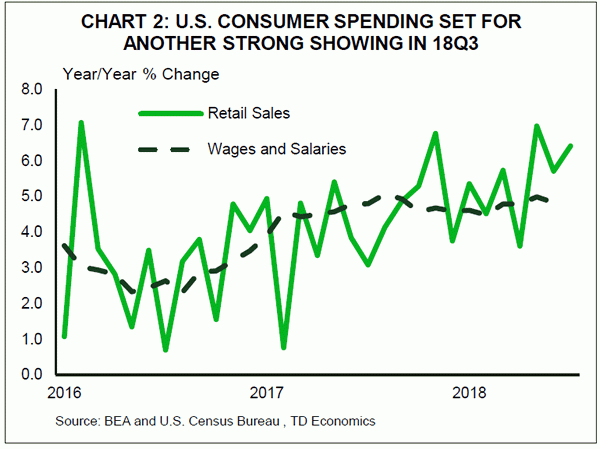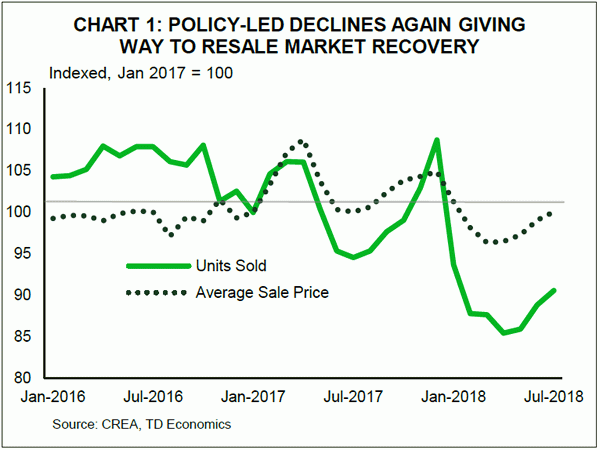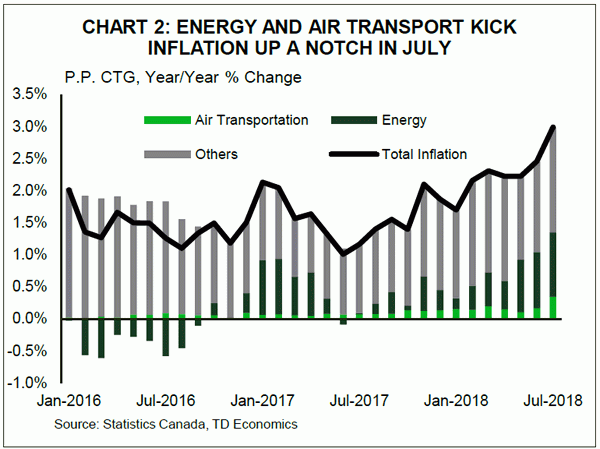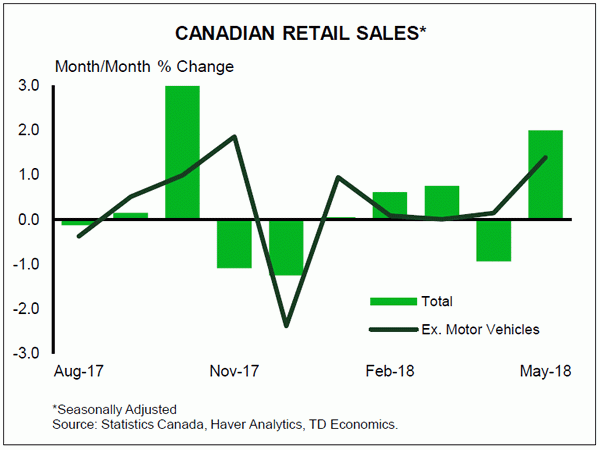U.S. Highlights
- Concerns about Turkey drove market volatility this week, but U.S. equity markets managed a rebound.
- Strong retail sales and historically-high small business optimism suggest a strong economic expansion in the U.S. this quarter.
- Although concerns eased by week’s end, Turkey is not out of the woods yet. It remains in the early stages of a balance of payments crisis, and is likely to trigger further bouts of market volatility.
Canadian Highlights
- Canadian economic data continued to impress this week. A solid resale housing report, respectable manufacturing numbers and surprisingly strong inflation all paint a picture of a healthy economy.
- Of particular note, home sales rose for a third straight month, as did average sale prices. Evidence continues to mount that, as expected, the impact of cooling measures early in the year have been short-lived, even if there remains lots of lost ground left for sales to make up.
- Economic risks remain very real, but continued solid out-turns suggest that the next policy interest rate hike is not that far off.
U.S. – Markets Brush Aside Emerging Market Fears For Now
Concerns about Turkey drove volatility in global financial markets this week, but U.S. equity markets rebounded as contagion fears diminished. A key factor driving emerging market concerns is the strong U.S. economy. Robust economic growth and rising interest rates favor U.S. assets, and the safe haven flows driven by emerging market fears drives dollar strength (Chart 1). This week, we received further affirmation that the U.S. economy is on course to post another strong showing this quarter. Retail sales, a key indicator of consumer spending, expanded 0.5% in July, well above expectations (Chart 2). Moreover, despite trade policy uncertainty and ever more acute labor shortages, small business optimism remains at a historical high. Although housing starts in July were somewhat disappointing, the combination of strong permits and rising wages should support a gradual uptick in construction in upcoming months.
As the U.S. economy hums along nicely, other economies are not faring so well. Turkey experienced a large selloff of assets and the lira as it failed to take action to calm debt fears. Last quarter, concerns about the financial outlook for Argentina drove a dramatic depreciation in the peso, forcing the central bank to raise domestic policy interest rates to 40% in an attempt to slow capital outflows. Like Argentina, Turkey depends heavily on foreign capital to finance domestic spending. Moreover, President Erdogan has weakened Turkey’s political institutions and refused to allow domestic interest rates to rise. This has amplified concerns that Turkey is headed for a debt crisis.
Like Argentina, Turkey is too small in the scope of the global economy to trigger a broader global crisis. Turkey’s economy is responsible for about 1.7% of global annual output (2016 purchasing power parity), a little more than Canada at 1.4%. Contagion risk via trade linkages is low, although Europe is most exposed. Similarly, financial contagion is limited, with Spanish, Italian, and French banks at risk to lose a tiny proportion of foreign loans.
That said, contagion to other economies can still occur through confidence and sentiment channels. That was evident this week with the turmoil in global financial markets that drove a selloff in risk assets and emerging market currencies, and a bid for developed market bonds. Further bouts of volatility are likely as emerging market economies with large imbalances are targeted one-by-one by increasingly discerning investors.
Although concerns eased by week’s end, Turkey is not out of the woods yet. It remains in the early stages of a balance of payments crisis. A sudden stop to capital inflows has occurred, and the next step for Turkey involves spending cuts and an emphasis on boosting exports to help generate foreign currency required to pay for its large external obligations. The medicine will be bitter, but the sooner Turkish authorities follow through with interest rate increases, capital controls, and fiscal spending cuts, the more likely they can mitigate the economic fallout.
Canada – Bench Strength
Concerns over the situation in Turkey dominated the economic headlines this week, but here in Canada, it was a much more constructive story, with a string of positive economic data out this week. How solid was the data? In the spirit of summer levity, perhaps a baseball analogy is in order.
First up to bat, hitting a double, was the latest read on the resale housing market. Sales activity was up for a third straight month, with more than half of local markets reporting activity gains. Why a double and not a homer? Activity in the GVA was stagnant, and some key markets, such as Calgary and Winnipeg, saw sales slip. Nevertheless, with the key Toronto market leading the way, average national price rose again for a third straight month, back to January 2017 levels (Chart 1). Past experience has shown that macroprudential cooling measures, such as the mortgage underwriting rules brought in at the start of this year, tend to have dramatic but short-lived impacts on activity (usually on the order of about 6 months). It seems this latest round is no different.
Next up was manufacturing sales. Back at it after an earlier injury (unexpected production disruptions in the energy sector), it hit a single. Sales rose a respectable 1.1% month-on-month in June, with volumes gaining 0.7%. Non-durable goods led the way – no big surprise as petroleum and coal product sales shot up 15.9% as facilities were back online. Durable goods came in a bit softer, flat in volume terms as gains in autos were offset by a decline in the volatile aerospace sector.
Given the respectable gain in overall sales, why does this data qualify as just a single? The forward-looking parts suggest some trouble on the horizon, with new orders falling on the month and unfilled orders up only a few ticks. What’s more, that old injury is set to flare back up: disruptions late in June at a sizeable Syncrude facility should serve to slow down over the summer months.
Inflation rounded things out. This data typically rates as a single, but July gave us a surprise double. Headline price growth hit 3% y/y for the first time since 2011 on the back of oil prices and surprise gains in transportation services (Chart 2: for the stats nerds out there, air transportation’s contribution was a six standard deviation event). Still, inflation pressures were not widespread, as the Bank of Canada’s core measures stayed at the 2% mark – on target and consistent with more rate increases, but rushing to hike on seeming one-offs would be an unforced error.
So, two doubles and a single: not a bad performance for this part of the lineup. There is, of course, still a risk of a bench-clearing brawl stemming from the trade front, where progress continues to be slow. Plus, housing may have turned in a double, but it can be injury prone. With elevated debt levels and adjustments ongoing in some markets, the team doctor will be watching this player closely. But, if you’re the Bank of Canada, the economic performance is clearly encouraging. So long as we stay brawl-free, more rate hikes are in store, with the next most likely to come this October.
Canada: Upcoming Key Economic Releases
Canadian Retail Sales – June*
Release Date: August 22, 2018
Previous: 2.0%, ex-auto: 1.4%
TD Forecast: -0.5%, ex-auto: -0.2%
Consensus: N/A
TD looks for retail sales to fall by 0.5% in June on a pullback in motor vehicles, while core measures should see a more modest decline. Preliminary data indicates a slowdown in auto sales but we do not expect a full unwind of May’s increase, which was largely a rebound from cold weather. Outside of autos, gasoline stations will also act as a modest headwind on lower prices at the pump, leaving ex-auto sales down 0.2%. In real terms, retail sales should decline by roughly 0.7% but rise by 2.9% (saar) for Q2 as a whole, consistent with a rebound in household consumption from the 1.1% pace in Q1.




